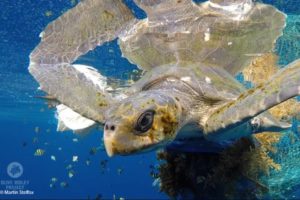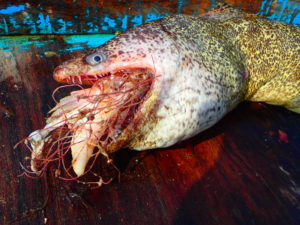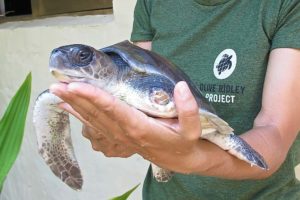Ghosts of the Ocean
March 6, 2017
By: Martin Stelfox, Olive Ridley Project
 A growing human population combined with an insatiable appetite for seafood has dramatically increased pressure on fishing communities worldwide. To keep up with the demand for seafood products, fishers around the world are replacing nets made with natural fibers like cotton and coconut to cheaper and stronger materials like plastics. While synthetic materials help fishers meet higher demands, they pose many new threats to marine habitats.
A growing human population combined with an insatiable appetite for seafood has dramatically increased pressure on fishing communities worldwide. To keep up with the demand for seafood products, fishers around the world are replacing nets made with natural fibers like cotton and coconut to cheaper and stronger materials like plastics. While synthetic materials help fishers meet higher demands, they pose many new threats to marine habitats.
The FAO estimates that 640,000 tons of fishing gear is abandoned, lost, and discarded in our oceans annually and has been given the term ‘ghost gear’. The majority of ghost hear is composed of plastic which does not biodegrade and has a much longer lifespan.
Fishers are the first to feel the brunt of losing their nets since they are costly to replace. However, in some occasions fishers purposefully toss damaged scraps of nets overboard because it is more economical. Sometimes nets can become snagged on the seabed, and pieces will rip away. If there are no means of repairing a net or purchasing a replacement, a fisher may be unable to fish which means they will generate no income. Small communities that rely on fishing for their livelihood are forced to compete with commercial fishing operations and in turn, suffer the most. If they do not fish, they do not eat.
The Problem With Ghost Nets
One major issue with ghost nets is they often fish at full capacity depending on the condition of the net. This process is called ghost fishing and is responsible for entangling thousands of sharks, birds, turtles, fish, eels, dolphins, whales, seals, dugongs and many more animals. Animal entanglements result in the loss of fins and flippers, strangulation, buoyancy issues, severe dehydration, stress, starvation, and death. While plenty of entangled animals are rescued, rehabilitated, and released back into the ocean, many are captured while many more go unnoticed.

Another issue is that animals large and small ingest nets. Recently, there has been significant documentation to show that the stomachs of numerous beached whales have been full of plastic nets. This picture of an eel attempting to eat an entangled fish shows that even smaller animals ingest nets since they are attracted to the marine life already caught in it.
Ghost nets know no boundaries. They can drift for years following the currents of the ocean, making them difficult to track. Ghost gear hotspots have been identified all over the world but the Maldivian archipelago in the Indian Ocean is a particularly extreme case. Nets are found daily and they have a major impact on the local fauna. Since the start of 2017, the Olive Ridley Project has recorded over 40 entangled olive ridley sea turtles. Most turtles are found with deep lacerations around the neck and flippers and in some cases leads to amputation. Despite proper rehabilitation, the loss of a flipper greatly reduces their chances of survival in the wild.
Make a Difference
Organizations worldwide are making efforts towards combatting the problem of ghost nets. Divers actively remove nets from the ocean in order to inhibit any further damage. Once removed, the material can lead a very different life. Some organization recycle the nets they find but since not all plastics can be recycled, others have found innovative ways to reuse them in building projects and handicrafts. For example, the Olive Ridley Project is working with a textile expert and the fishing community of Rehman Goth in Karachi, Pakistan to find another life for hazardous nets. The initiative also provides another source of income for a community strained by commercial fishing operations. Although important, removal and reuse are only short-term solutions. Finding long-term solutions requires data collection to provide researchers details about where to travel and how to interact with animals. Creating awareness and working directly with the fishing industry are also key to tackling the problem.

If you don’t live by the ocean or are unable to remove nets, there are other ways to help. Remember, what you do matters particularly when it concerns how you spend your money. As a consumer, it’s important to make responsible choices by being informed about how your fish products are caught. Purchasing seafood caught using pole and line not only reduces ghost gear, but also diminishes bycatch. Buying locally sourced fish caught by small-scale fisheries helps to promote industry in your area, whilst not overexploiting fish stocks. Make educated choices about the food you buy. Many UK and US retailers sell fish caught by pole and line and they are often less expensive alternatives than name brand options. Purchasing sustainable products costs you nothing but it does so much for the environment.








We must stop chucking all this rubbish in the ocean….It will be to late one day, the whole world has to start making changes….